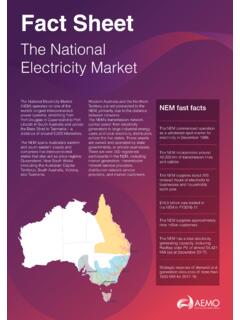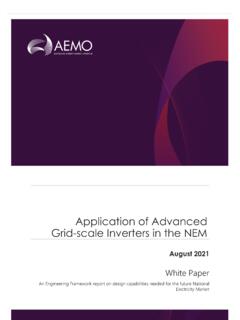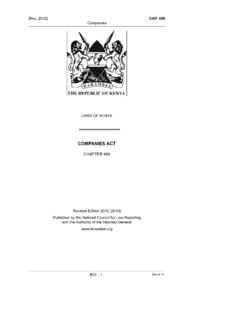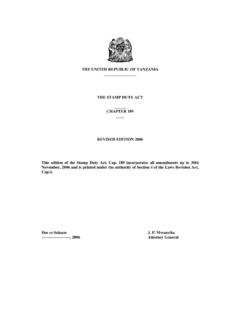Transcription of Electric vehicle projections 2021
1 Australia's National Science Agency Electric vehicle projections 2021. Paul Graham and Lisa Havas May 2021. Citation Graham, and Havas, L. 2021, Electric vehicle projections 2021, CSIRO, Australia. Copyright Commonwealth Scientific and Industrial Research Organisation 2021. To the extent permitted by law, all rights are reserved and no part of this publication covered by copyright may be reproduced or copied in any form or by any means except with the written permission of CSIRO. Important disclaimer CSIRO advises that the information contained in this publication comprises general statements based on scientific research.
2 The reader is advised and needs to be aware that such information may be incomplete or unable to be used in any specific situation. No reliance or actions must therefore be made on that information without seeking prior expert professional, scientific and technical advice. To the extent permitted by law, CSIRO (including its employees and consultants). excludes all liability to any person for any consequences, including but not limited to all losses, damages, costs, expenses and any other compensation, arising directly or indirectly from using this publication (in part or in whole) and any information or material contained in it.
3 CSIRO is committed to providing web accessible content wherever possible. If you are having difficulties with accessing this document please contact Electric vehicle projections 2021 | i Contents Acknowledgments ..iv Executive summary .. v 1 Introduction .. 1. 2 Methodology .. 2. Adoption projections method overview .. 2. Demographic factors and weights .. 8. Role of economic growth in projection method .. 9. 3 Scenario definitions .. 10. Financial and non-financial scenario drivers .. 14. 4 Data assumptions .. 23. Technology costs .. 23. Electricity tariffs .. 25. Income and population growth.
4 27. Separate dwellings and home ownership .. 28. vehicle market segmentation .. 30. vehicle to home or grid .. 35. Shares of Electric vehicle charging behaviour .. 36. Transport demand .. 36. Non-road electrification .. 42. 5 projections results .. 44. Sales and fleet share .. 44. Electric vehicle numbers and consumption .. 46. Charging profiles .. 51. Additional data assumptions .. 53. Shortened forms .. 54. References .. 57. Figures Figure 2-1 Historical and projected Electric vehicle sales by state to 2022, Current Trajectory scenario .. 3. Figure 2-2: Overview of transport demand model .. 4.
5 Electric vehicle projections 2021 | i Figure 2-3 Adoption model methodology overview .. 7. Figure 4-1 Assumed share of separate dwellings in total dwelling stock by scenario .. 29. Figure 4-2 Historical (ABS Census) and projected share of homes owned outright or mortgaged, source AIHW (2017) .. 30. Figure 4-3 Historical and projected passenger transport demand .. 37. Figure 4-4 Historical and projected freight transport demand .. 37. Figure 4-5 Share of passenger and freight autonomous vehicles in the road vehicle fleet by scenario by 2050 .. 39. Figure 4-6 Comparison of 2018-19 and 2019-20 vehicle utilisation by vehicle type.
6 40. Figure 4-7 Historical and projected national road vehicle kilometres travelled, all road modes 41. Figure 4-8 Projected national road vehicle fleet by scenario .. 42. Figure 5-1 Projected sales share, all Electric vehicles, compared to selected 2020 projections . 45. Figure 5-2 Projected fleet share, all Electric vehicles, compared to selected 2020 projections .. 46. Figure 5-3 Projected number of BEVs in the NEM .. 47. Figure 5-4 Projected number of BEVs in the SWIS .. 47. Figure 5-5 Projected number of vehicles in the NEM by 2050, all Electric vehicles by type .. 48. Figure 5-6 Projected number of vehicles in the SWIS by 2050, all Electric vehicles by type.
7 49. Figure 5-7 Projected electricity consumption by BEVs in the NEM .. 50. Figure 5-8 Projected electricity consumption by BEVs in the 50. Figure 5-9 Average daily charging profiles for light passenger vehicles .. 51. Figure 5-10 Average daily charging profiles for rigid trucks .. 52. Apx Figure Electric vehicle fuel efficiency by road mode .. 53. Tables Table 2-1 Weights and factors for Electric vehicles .. 9. Table 3-1 AEMO scenario 12. Table 3-2 Extended scenario 14. Table 3-3: Economic drivers of Electric and fuel cell Electric vehicles (FCEV) and approach to including them in scenarios .. 15.
8 Table 3-4: Economic drivers of autonomous private and ride share vehicles and approach to including them in scenarios .. 16. Table 3-5: Infrastructure drivers for Electric and fuel cell vehicles and approach to including them in scenarios .. 17. ii | CSIRO Australia's National Science Agency Table 3-6 Emerging or potential disruptive business models to support embedded technology adoption .. 18. Table 3-7 Electric vehicle policy settings by scenario .. 22. Table 4-1 Current Trajectory scenario internal combustion and Electric vehicle cost assumptions, 2020 $'000 .. 24. Table 4-2 Average annual percentage growth in GSP to 2050 by state and scenario, source: AEMO and economic consultant.
9 28. Table 4-3 Average annual percentage rate of growth in customers to 2050 by state and scenario (Pre-COVID-19), source: AEMO and economic consultant .. 28. Table 4-4 Non-financial limitations on Electric and fuel cell vehicle uptake and the calculated maximum market share .. 32. Table 4-5 Shares of different Electric vehicle charging behaviours by 2050 based on limiting factor analysis .. 34. Table 4-6 Assumed changes in vehicle utilisation and rationale .. 40. Table 4-7 Rail freight and aviation electrification assumptions .. 43. Electric vehicle projections 2021 | iii Acknowledgments This report has benefited from input from AEMO staff and the AEMO Forecasting Reference Group.
10 Iv | CSIRO Australia's National Science Agency Executive summary This report was commissioned by AEMO to provide a record of the methodology, assumptions and outputs of electricity vehicle projections provided by CSIRO to support their planning and forecasting tasks. Electric vehicles projections have been provided for five scenarios: Slow Growth, Current Trajectory, Sustainable Growth and Export Superpower and a Rapid Decarbonisation sensitivity case. Compared to previous projections by CSIRO, this forecast set has a stronger emphasis on net zero greenhouse gas emission targets for Australia of which the road sector would be expected to contribute.






